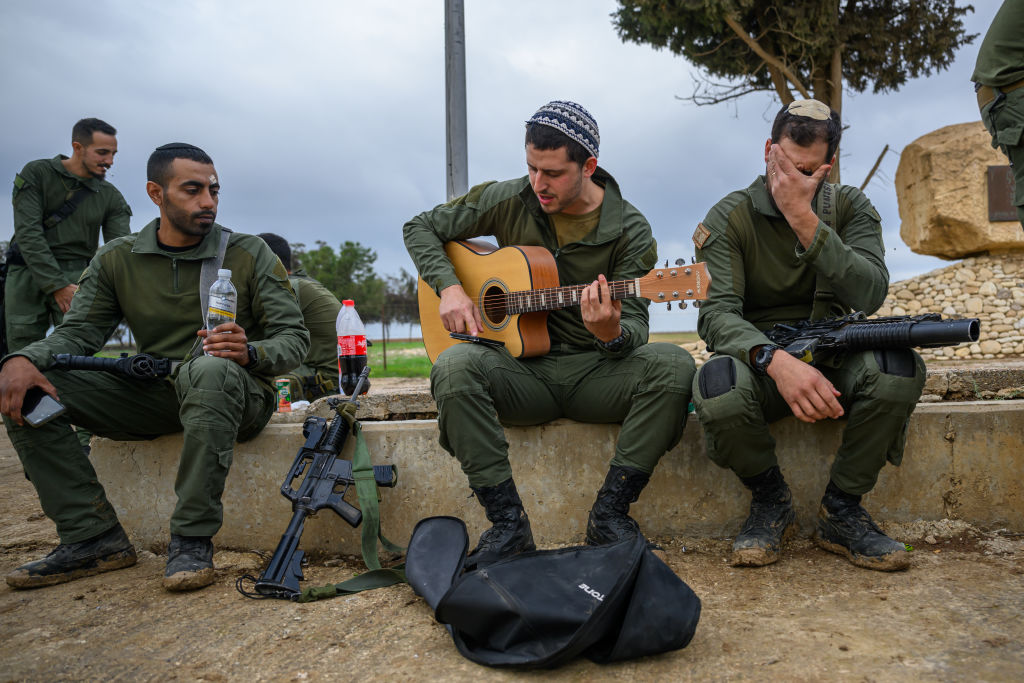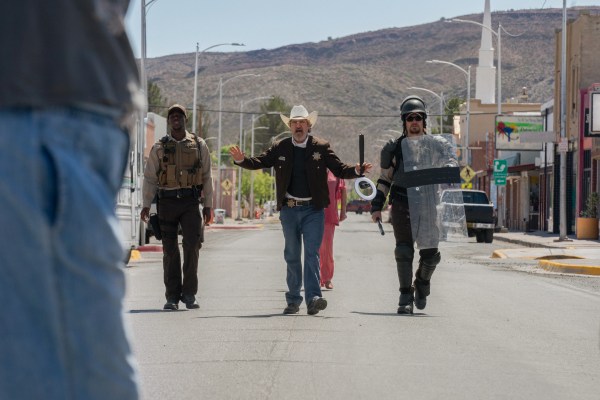TEL AVIV, Israel—On Monday, 24 Israeli troops died fighting in Gaza, marking the military’s deadliest day since the ground war’s start in October. Among the fallen were Adam Bismut, a tech entrepreneur who developed an artificial intelligence system to prevent people from drowning; Elkana Vizel, an elementary school teacher and father of four; and Ahmad Abu Latif, a Bedouin who volunteered to fight after Hamas’ October 7 attack.
Each of them, along with 18 others killed in a single incident that day, was a reservist. As the conflict approaches its fourth month, Monday’s tragedy underscored the difficulties facing the 360,000 citizen soldiers who have put their normal lives on hold to serve in Israel’s longest war since its 1948 fight for independence.
While some reservists face a fierce urban battlefield in Gaza, others are deployed along Israel’s northern border with Lebanon, where intensifying rocket and missile attacks by Hezbollah present a deadly challenge to troops holding the line. Still others have been tasked with reinforcing Israeli Defense Forces (IDF) positions in the West Bank to prevent violence there.
Israel relies on compulsory military service to fill the ranks of its standing army, which in wartime is supposed to hold the line for 12 to 24 hours before the reserves can be mobilized. The majority of the country’s active duty soldiers are expected to transition to reserve units once they complete their mandatory service. After Israel was attacked last year, hundreds of thousands of reservists were called up and thousands of other Israeli civilians volunteered to fight.
In all, the large-scale deployment of reservists combined with Israel’s active military force—which estimates put at nearly 170,000 soldiers—means that roughly 6 percent of the country’s total population has been in uniform at some point during this war. And for every reservist called to serve, there are families, jobs, and studies awaiting their return on the homefront.
“These are not faceless soldiers. These are our fathers and brothers and mothers and sisters and daughters,” said Michael Oren, the former Israeli ambassador to the United States who himself spent 35 years in the IDF reserves. They’re also “the backbone of our economy,” he added, pointing out that reservists tend to be older than regular soldiers, and have well-developed careers.
Their absence from Israel’s workforce is felt. The Bank of Israel estimated that the country’s economy shrank 2 percent in the last three months of 2023. The labor loss alone has cost Israel’s economy about $600 million per week—roughly 6 percent of the country’s weekly gross domestic product. Israel’s high tech industry, which accounts for half of Israel’s exports, has taken a particular hit, with a significant share of its young workforce on the front lines.
The military began gradually allowing reservists to return home as it shifted to the next, lower intensity phase of the operation in Gaza earlier this month. The move is expected to alleviate the economic toll of the ongoing war, but between 200,000 and 250,000 Israelis are still mobilized with no concrete release date in sight.
Such is the case for Harel Baruchi, a web developer who has been stationed in the West Bank since October 7. “It’s all in the air. He’s been given three potential release dates, but it just keeps getting pushed off,” his wife, Sabrina, told The Dispatch. In the meantime, she is working a full-time job in the tech sector while also caring for two children under the age of 3. “I’ve essentially become the single parent,” she said.
And this may be just the start of a long and difficult process. Many government officials and medical professionals have begun to express concerns over the challenges of reintegrating a large fighting force into the civilian population post-war.
For many reservist soldiers, this conflict was their first time experiencing combat. In peacetime, reservists are typically called up for as many as 60 total days in a year, but that time is typically spent conducting training exercises or patrolling Israel’s borders. Now they’re facing a war unique in its intensity and length. More than 200 soldiers have been killed and thousands more have been wounded in intense, urban battles in the Gaza Strip. And in contrast to Israel’s other wars, many troops have been on the front lines for months at a time.
Long deployments typically correlate with greater instances of post-traumatic stress disorder (PTSD)—an additional societal strain for which Israeli institutions are already bracing. Tel Aviv University recently announced the opening of a national trauma center, estimating that at least 30,000 new cases of PTSD and related issues will result from this war.
The northern border with Lebanon creates an added layer of uncertainty. Some reservists discharged from Gaza have been instructed to train for or report to the northern front, where cross-border rocket fire with Hezbollah shows no signs of slowing. At least 80,000 residents of northern communities have been evacuated by the military, and many are unwilling or unable to return home with the Iranian-backed terrorist group stationed along the border.
“If Hezbollah does not withdraw, the entire state of Lebanon will pay the price,” Israeli Foreign Minister Israel Katz warned during a meeting with his British counterpart on Wednesday. With no diplomatic solution in sight, many Israelis see all-out war with Hezbollah as a question of when, not if. In a December 2023 poll, the majority of Israelis responded that the country “should deal Hezbollah a heavy blow now, even at the cost of opening up another front in the north.”
Israeli reservists overwhelmingly consider these fights worth having. After a brief period of concern that reservists wouldn’t report for duty due to pre-war boycotts over the government’s judicial reform plan, an estimated 120 percent showed up to fight in the early days of the war—including many without call-up orders and thousands who returned to Israel from overseas to serve. That enthusiasm has carried into the conflict’s 110th day. Despite representing a large and diverse subset of Israeli society, reservist forces still appear largely supportive of the war effort.
Asaf Eliyahu, a reservist in the 13th Battalion of the highly decorated Golani Brigade, described the fight against Hamas after October 7 as a “sacred mission” for him. “If they call me back I will go again. I will run back again. We don’t have any other place to go. This is our country,” he told The Dispatch. “Either we live here or we die here.”
That sentiment—that Israel is fighting to rid itself of an existential threat—is shared by the many thousands of citizen soldiers who have taken up arms in the aftermath of Hamas’ massacre. “The reservists for the most part understand that there’s really no choice but to keep up the pressure on Hamas and keep up this campaign, costly as it is,” Ambassador Oren said. “And it’s immeasurably costly.”
The current round of fighting “dispelled a myth that had gained currency in the years before the war, which is that Israel could pretty much rely on its regular army—the conscripts, the professional soldiers—and didn’t need the reservists as much as it needed them in the past,” he added. “We cannot fight this war, or perhaps any war, without them.”







Please note that we at The Dispatch hold ourselves, our work, and our commenters to a higher standard than other places on the internet. We welcome comments that foster genuine debate or discussion—including comments critical of us or our work—but responses that include ad hominem attacks on fellow Dispatch members or are intended to stoke fear and anger may be moderated.
With your membership, you only have the ability to comment on The Morning Dispatch articles. Consider upgrading to join the conversation everywhere.